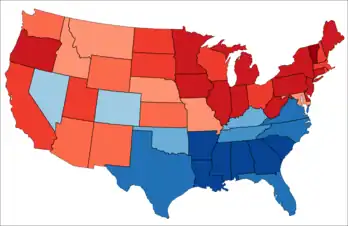第四政党体系
第四政黨體系是1896年至1932年期間美国的政治生態。1890年至1920年期間的這段時間也被稱為进步时代。此外1896年至1932年期間的重要事件還有第一次世界大战和大蕭條的爆發。1896年至1932年的大部分時間內,美國的執政黨是共和黨,期間只有1912年美國總統選舉之後的八年內美國由民主党執政。[1]
.svg.png.webp) | ||
| ||
|
| ||
 1896至1928年间的美国总统选举结果。蓝色州通常投票给民主党,而红色州通常投票给共和党。 | ||
第四政党体系時代,美國國內的重要議題有政府對鐵路和大型企業(托拉斯)的監管、貨幣問題(金本位與銀本位)、保護性關稅、勞工工會問題、童工問題、黨派政治中的腐敗、初選制度、聯邦所得稅的引入、參議員的直接選舉、種族隔離、政府效能、婦女選舉權和移民管控。外交政策的議題主要有1898年的美西战争、帝国主义、墨西哥革命、第一次世界大戰和國際聯盟的創建。期间重要的人物有總統威廉·麦金莱(共和黨)、西奥多·罗斯福(共和黨)和伍德罗·威尔逊(民主黨),三届總統選舉候選人威廉·詹宁斯·布莱恩(民主黨)以及來自威斯康星州的罗伯特·拉福莱特。
参考文献
- To cite a standard political science college textbook: "Scholars generally agree that realignment theory identifies five distinct party systems with the following approximate dates and major parties: 1. 1796–1816, First Party System: Jeffersonian Republicans and Federalists; 2. 1840–1856, Second Party System: Democrats and Whigs; 3. 1860–1896, Third Party System: Republicans and Democrats; 4. 1896–1932, Fourth Party System: Republicans and Democrats; 5. 1932–, Fifth Party System: Democrats and Republicans." Robert C. Benedict, Matthew J. Burbank and Ronald J. Hrebenar, Political Parties, Interest Groups and Political Campaigns. Westview Press. 1999. Page 11.
This article is issued from Wikipedia. The text is licensed under Creative Commons - Attribution - Sharealike. Additional terms may apply for the media files.